Heat-Induced Pore Structure Evolution in the Triassic Chang 7 Shale, Ordos Basin, China: Experimental Simulation of In Situ Conversion Process
Abstract
:1. Introduction
2. Samples and Experiments
2.1. Regional Geological Characteristics and Sampling Location
2.2. ICP Simulation Experiments
2.3. Analytical Techniques
3. Results and Discussion
3.1. Changes in Shale Composition before and during Heating
3.1.1. Changes in Mineral Composition
3.1.2. Changes in Geochemical Characteristics
3.1.3. Changes in Maceral Composition
3.2. Changes in Shale Pores and Fractures during Heating
3.3. Changes in Shale Porosity and Permeability during Heating
4. Conclusions
- (1)
- The pore structure, porosity, and permeability of the Chang 7 shale improved substantially during the ICP, with a temperature threshold of approximately 350 °C being identified for a sharp change in mineral and maceral composition, pore structure, porosity, and permeability.
- (2)
- After heating to 320 °C, K-feldspar, ankerite, and siderite were completely decomposed, clay was dehydrated, and there was little change in the content of quartz and plagioclase. Pyrite became completely decomposed after further heating to 410 °C. Afterwards, the temperature continued to rise, and there was no significant change in mineral composition.
- (3)
- The geochemical characteristics did not change substantially up to 320 °C. As the temperature rose to 370 °C, the peak of the oil-generation window was reached, characterized by asphalt continuing to be cracked into liquid hydrocarbons with high saturated hydrocarbon and aromatic hydrocarbon contents, and S1 reached its maximum value. After further heating to 400–450 °C, it was the end of the oil-generation window and transition to the wet-gas-generation stage.
- (4)
- After further heating to 370 °C, the content of sapropelite decreased markedly to 15.6%, and exinite essentially disappeared. A large amount of oil asphalt was generated (40.6%). After further heating to 410 °C, the sapropelite content continued to decrease to 1.4%, and the asphaltene content decreased to 22.6%. As the temperature rose to 450 °C, sapropelite disappeared, and the shale displayed no fluorescence.
- (5)
- Small numbers of secondary pores and thermal fractures were locally generated in the shale at 320 °C, but the porosity and permeability showed negligible changes. A three-scale millimeter–micrometer–nanometer pore–fracture network was formed along the shale bedding planes, between OM and mineral particles and within OM, respectively, as a result of kerogen pyrolysis, the transformation of clay minerals, the dissolution of unstable minerals, and thermal stress. Both the porosity and permeability improved substantially, with the porosity increasing by a factor of 10 and the permeability increasing by 2–4 orders of magnitude through the range of heating from 20 to 450 °C.
Author Contributions
Funding
Institutional Review Board Statement
Informed Consent Statement
Data Availability Statement
Acknowledgments
Conflicts of Interest
References
- Zhao, W.; Hu, S.; Hou, L. Connotation and strategic role of in-situ conversion processing of shale oil underground in the onshore China. Pet. Explor. Dev. 2018, 45, 563–572. [Google Scholar] [CrossRef]
- Hou, L.; Cui, J.; Zhang, Y. Evolution mechanism of dynamic thermal parameters of shale. Mar. Pet. Geol. 2021, 138, 105423. [Google Scholar] [CrossRef]
- Liu, B.; Jiang, X.-W.; Bai, L.-H.; Lu, R.-S. Investigation of oil and water migrations in lacustrine oil shales using 20 MHz 2D NMR relaxometry techniques. Pet. Sci. 2021, 19, 1007–1018. [Google Scholar] [CrossRef]
- Hou, L.; Yu, Z.; Luo, X.; Lin, S.; Zhao, Z.; Yang, Z.; Wu, S.; Cui, J.; Zhang, L. Key geological factors controlling the estimated ultimate recovery of shale oil and gas: A case study of the Eagle Ford shale, Gulf Coast Basin, USA. Pet. Explor. Dev. 2021, 48, 762–774. [Google Scholar] [CrossRef]
- Ma, W.; Hou, L.; Luo, X.; Liu, J.; Tao, S.; Guan, P.; Cai, Y. Generation and expulsion process of the Chang 7 oil shale in the Ordos Basin based on temperature-based semi-open pyrolysis: Implications for in-situ conversion process. J. Pet. Sci. Eng. 2020, 190, 107035. [Google Scholar] [CrossRef]
- Hou, L.; Luo, X.; Mi, J.; Zhang, Y.; Lin, S.; Liao, F.; Pang, Z.; Yu, Z. Characteristics of Oil and Gas Produced by In Situ Heating of Shale: A Case Study of the Chang 7 Member, Ordos Basin, China. Energy Fuels 2022, 19, 441–458. [Google Scholar] [CrossRef]
- Burnham, A.K.; Mcconaghy, J.R. Comparison of the acceptability of various oil shale processes. In Proceedings of the 26th Oil Shale Symposium, Golden, CO, USA, 16–18 October 2006. [Google Scholar]
- Fowler, T.D.; Vinegar, H.J. Oil shale ICP-Colorado Field Pilots. In Proceedings of the SPE Western Regional Meeting, San Jose, CA, USA, 24–26 March 2009; pp. 1–15. [Google Scholar]
- Tanaka, P.L.; Yeakel, J.D.; Symington, W.A.; Meurer, W.; Spiecker, P.M.; Pico, M.D.; Thomas, M.; Sullivan, K.; Stone, M. Plan to test ExxonMobil′s in situ oil shale technology on a proposed RD & Dlease. In Proceedings of the Oil Shale Symposium, Golden, CO, USA, 17–21 October 2011. [Google Scholar]
- Alpak, F.O.; Vink, J.C.; Gao, G.; Mo, W. Techniques for Effective Simulation, Optimization, and Uncertainty Quantification of the In-situ Upgrading Process. J. Unconv. Oil Gas Resour. 2013, 3–4, 1–14. [Google Scholar] [CrossRef]
- Hou, L.; Ma, W.; Luo, X.; Liu, J. Characteristics and quantitative models for hydrocarbon generation-retention-production of shale under ICP conditions: Example from the Chang 7 member in the Ordos Basin. Fuel 2020, 279, 118497. [Google Scholar] [CrossRef]
- Kang, Z.; Zhao, Y.; Yang, D. Review of oil shale in-situ conversion technology. Appl. Energy 2020, 269, 115121. [Google Scholar] [CrossRef]
- He, W.; Meng, Q.; Lin, T.; Wang, R.; Liu, X.; Ma, S.; Li, X.; Yang, F.; Sun, G. Evolution of in-situ permeability of low-maturity shale with the increasing temperature, Creta-ceous Nenjiang Formation, northern Songliao Basin, NE China. Pet. Explor. Dev. 2022, 49, 516–529. [Google Scholar] [CrossRef]
- Tiwari, P.; Deo, M.; Lin, C.; Miller, J. Characterization of oil shale pore structure before and after pyrolysis by using X-ray micro CT. Fuel 2013, 107, 547–554. [Google Scholar] [CrossRef]
- Glatz, G.; Castanier, L.M.; Kovscek, A.R. Visualization and Quantification of Thermally Induced Porosity Alteration of Immature Source Rock Using X-ray Computed Tomography. Energy Fuels 2016, 30, 8141–8149. [Google Scholar] [CrossRef]
- Burnham, A.K. Porosity and permeability of Green River oil shale and their changes during retorting. Fuel 2017, 203, 208–213. [Google Scholar] [CrossRef]
- Saif, T.; Lin, Q.; Bijeljic, B.; Blunt, M.J. Microstructural imaging and characterization of oil shale before and after pyrolysis. Fuel 2017, 197, 562–574. [Google Scholar] [CrossRef]
- Liu, J.; Liang, W.; Kang, Z.; Lian, H.; Geng, Y. Study on the quantitative model of oil shale porosity in the pyrolysis process based on pyrolysis kinetics. Oil Shale 2018, 35, 128. [Google Scholar] [CrossRef] [Green Version]
- Han, J.; Sun, Y.H.; Guo, W. Characterization of pyrolysis of Nong’An oil shale at different temperatures and analysis of pyrol-ysate. Oil Shale 2019, 36, 151–170. [Google Scholar] [CrossRef]
- Kim, T.W.; Ross, C.M.; Guan, K.M.; Burnham, A.K.; Kovscek, A.R. Permeability and Porosity Evolution of Organic-Rich Shales from the Green River Formation as a Result of Maturation. SPE J. 2020, 25, 1377–1405. [Google Scholar] [CrossRef]
- Zafar, A.; Su, Y.; Wendong, W.; Kashif, M.; Mehmood, A.; Alam, S.G. Evaluation of the porosity and permeability of oil shale during in-situ conversion process through numerical simulation and mathematical modeling. Oil Shale 2020, 37, 319. [Google Scholar] [CrossRef]
- Wang, G.; Yang, D.; Zhao, Y.; Kang, Z.; Zhao, J.; Huang, X. Experimental investigation on anisotropic permeability and its relationship with anisotropic thermal cracking of oil shale under high temperature and triaxial stress. Appl. Therm. Eng. 2018, 146, 718–725. [Google Scholar] [CrossRef]
- Zhao, J.; Kang, Z. Permeability of Oil Shale Under In Situ Conditions: Fushun Oil Shale (China) Experimental Case Study. Nat. Resour. Res. 2020, 30, 753–763. [Google Scholar] [CrossRef]
- Cui, J.; Zou, C.; Zhu, R. New Advances in Shale Porosity Research. Adv. Earth Sci. 2012, 27, 1319–1325, (In Chinese with English Abstract). [Google Scholar]
- Wu, S.; Yang, Z.; Zhai, X.; Cui, J.; Bai, L.; Pan, S.; Cui, J. An experimental study of organic matter, minerals and porosity evolution in shales within high-temperature and high-pressure constraints. Mar. Pet. Geol. 2018, 102, 377–390. [Google Scholar] [CrossRef]
- Jiang, X.; Wu, S.; Hou, L.; Zhang, J.; Guan, M.; Zhai, F.; Guo, J.; Su, L.; Liao, F.; Ding, L. Porosity Evolution in Lacustrine Organic-Matter-Rich Shales With High Claly Minerals Content. Front. Earth Sci. 2021, 9, 766093. [Google Scholar] [CrossRef]
- Chen, G.H.; Jiang, N.; Li, C.; Li, S.S.; Peng, P.; Mo, L.; Zhang, Y.Y.; Zhang, L.C.; Zhang, T.Y. Progress in shale reservoir upgrading through in-situ heating. OIL GAS Geol. 2022, 43, 286–296, (In Chinese with English Abstract). [Google Scholar]
- Liu, B.; Nakhaei-Kohani, R.; Bai, L.; Wen, Z.; Gao, Y.; Tian, W.; Yang, L.; Liu, K.; Hemmati-Sarapardeh, A.; Ostadhassan, M. Integrating advanced soft computing techniques with experimental studies for pore structure analysis of Qingshankou shale in Southern Songliao Basin, NE China. Int. J. Coal Geol. 2022, 257, 103998. [Google Scholar] [CrossRef]
- Wei, Z.; Sheng, J. Changes of pore structures and permeability of the Chang 73 medium-to-low maturity shale during in-situ heating treatment. Energy 2022, 248, 123609. [Google Scholar] [CrossRef]
- Liu, D.; Li, H.; Zhang, C.; Wang, Q.; Peng, P. Experimental investigation of pore development of the Chang 7 member shale in the Ordos basin under semi-closed high-pressure pyrolysis. Mar. Pet. Geol. 2018, 99, 17–26. [Google Scholar] [CrossRef]
- Li, G.; Li, G.; Luo, C.; Zhou, R.; Zhou, J.; Yang, J. Dynamic evolution of shale permeability under coupled temperature and effective stress conditions. Energy 2023, 266, 126320. [Google Scholar] [CrossRef]
- Wu, S.; Zhu, R.; Cui, J.; Cui, J.; Bai, B.; Zhang, X.; Jin, X.; Zhu, D.; You, J.; Li, X. Characteristics of lacustrine shale porosity evolution, Triassic Chang 7 Member, Ordos Basin, NW China. Pet. Explor. Dev. 2015, 42, 185–195. [Google Scholar] [CrossRef]
- Li, J.; Wang, S.; Dong, K.; Meng, S.; Lu, Q.; Li, Z. Effects of in-situ temperature in deep reservoirs on shale fracture properties. Energy Rep. 2023, 9, 73–83. [Google Scholar] [CrossRef]
- Ge, Z.; Sun, Q.; Gao, Q.; Li, D.; Zhang, Y.; Huang, H. Thermoacoustic emission characteristics and real-time damage evolution in shales of the Lower Palaeozoic Niutitang Formation. Int. J. Rock Mech. Min. Sci. 2022, 157, 105175. [Google Scholar] [CrossRef]
- Xu, L.; Yang, K.; Wei, H.; Liu, L.; Li, X.; Chen, L.; Xu, T.; Wang, X. Diagenetic evolution sequence and pore evolution model of Mesoproterozoic Xiamaling organic-rich shale in Zhangjiakou, Hebei, based on pyrolysis simulation experiments. Mar. Pet. Geol. 2021, 132, 105233. [Google Scholar] [CrossRef]
- Guan, M.; Liu, X.; Jin, Z.; Lai, J.; Sun, B.; Zhang, P.; Chen, K. The evolution of pore structure heterogeneity during thermal maturation in lacustrine shale pyrolysis. J. Anal. Appl. Pyrolysis 2022, 163, 105501. [Google Scholar] [CrossRef]
- Guo, H.; Jia, W.; He, R.; Yu, C.; Song, J.; Peng, P. Distinct evolution trends of nanometer-scale pores displayed by the pyrolysis of organic matter-rich lacustrine shales: Implications for the pore development mechanisms. Mar. Pet. Geol. 2020, 121, 104622. [Google Scholar] [CrossRef]
- Cao, T.; Deng, M.; Cao, Q.; Huang, Y.; Yu, Y.; Cao, X. Pore formation and evolution of organic-rich shale during the entire hydrocarbon generation process: Examination of artificially and naturally matured samples. J. Nat. Gas Sci. Eng. 2021, 93, 104020. [Google Scholar] [CrossRef]
- Guo, H.; Jia, W.; Peng, P.; Zeng, J.; He, R. Evolution of organic matter and nanometer-scale pores in an artificially matured shale undergoing two distinct types of pyrolysis: A study of the Yanchang Shale with Type II kerogen. Org. Geochem. 2017, 105, 56–66. [Google Scholar] [CrossRef]
- Hou, L.; Lin, S.; Zhang, L. New insights from geostatistics on the genetic relationship between shales, mudstones, and sandstones within a parasequence in the lower Chang7 Member of the Upper Triassic Yanchang Formation, Ordos Basin, Northern China. J. Asian Earth Sci. 2021, 213, 104767. [Google Scholar] [CrossRef]
- Espitalié, J.; Marquis, F.; Barsony, I. Geochemical logging. In Analytical Pyrolysis; Voorhess, K.J., Ed.; Butterworths: Boston, MA, USA, 1984; pp. 53–79. [Google Scholar]
- Taylor, G.H.; Teichmüller, M.; Davis, A.C.F.K.; Diessel, C.F.K.; Littke, R.; Robert, P. Organic Petrology; Borntraeger: Berlin/Stuttgart, Germany, 1998. [Google Scholar]
- Yuan, W. Formation Mechanism of the Organic-Rich Shales in the 7th Member of Yanchang Formation, Ordos Basin; China University of Petroleum: Beijing, China, 2018. [Google Scholar]
- Er, C.; Luo, A.; Zhao, J.; Zhang, Z.; Bai, Y.; Bai, Y.; Chen, D.-X.; Tun, W.-C.; Wei, Z.-K.; Zhang, J. Lithofacies features of organic-rich shale of the Triassic Yanchang Formation in Huachi Aera, Ordos Basin. Earth Sci. Front. 2016, 23, 108–117. [Google Scholar]
- Chen, H.; Li, B.; Zhang, B. Decomposition of Pyrite and the Interaction of Pyrite with Coal Organic Matrix in Pyrolysis and Hy-dropyrolysis. Fuel 2000, 79, 1627–1631. [Google Scholar] [CrossRef]
- Mohnhoff, D.; Littke, R.; Krooss, B.M.; Weniger, P. Flow-through extraction of oil and gas shales under controlled stress using organic solvents: Implications for organic matter-related porosity and permeability changes with thermal maturity. Int. J. Coal Geol. 2016, 157, 84–99. [Google Scholar] [CrossRef]
- Schwark, L.; Stoddart, D.; Keuser, C.; Spitthoff, B.; Leythaeuser, D. A novel sequential extraction system for whole core plug ex-traction in a solvent flow-through cell: Application to extraction of residual petroleum from an intact pore-system in secondary migration studies. Org. Geochem. 1997, 26, 19–31. [Google Scholar] [CrossRef]
- Ma, Z.; Zheng, L.; Li, Z. The Thermocompression simulation experiment of source rock hydrocarbon generation and expulsion in formation porosity. Acta Sedimentol. Sin. 2012, 30, 955–963. [Google Scholar]
- Liu, B.; Wang, Y.; Tian, S.; Guo, Y.; Wang, L.; Yasin, Q.; Yang, J. Impact of thermal maturity on the diagenesis and po-rosity of lacustrine oil-prone shales: Insights from natural shale samples with thermal maturation in the oil generation window. Int. J. Coal Geol. 2022, 261, 104079. [Google Scholar] [CrossRef]
- Liu, B.; Mohammadi, M.-R.; Ma, Z.; Bai, L.; Wang, L.; Xu, Y.; Ostadhassan, M.; Hemmati-Sarapardeh, A. Evolution of porosity in kerogen type I during hydrous and anhydrous pyrolysis: Experimental study, mechanistic understanding, and model development. Fuel 2023, 338, 127149. [Google Scholar] [CrossRef]
- Kibodeaux, K.R. Evolution of porosity, permeability, and fluid saturations during thermal conversion of oil shale. In Proceedings of the SPE Annual Technical Conference and Exhibition, Amsterdam, The Netherlands, 27–29 October 2014. [Google Scholar]
- Wang, G.; Yang, D.; Kang, Z. Experimental study on anisotropic permeability of oil shale under high temperature and triaxial stress. Chin. J. Rock Mech. Eng. 2020, 39, 1129–1141. [Google Scholar]
- Thomas, G.W. Some effects of overburden pressure on oil shale during underground retorting. In Proceedings of the SPE Annual Fall Meeting, Denver, CO, USA, 3–6 October 1966. [Google Scholar]
- Sun, Y.; Bai, F.; Liu, B.; Liu, Y.; Guo, M.; Guo, W.; Wang, Q.; Lü, X.; Yang, F.; Yang, Y. Characterization of the oil shale products derived via topochemical reaction method. Fuel 2014, 115, 338–346. [Google Scholar] [CrossRef]
- Bai, F.; Sun, Y.; Liu, Y.; Guo, M. Evaluation of the porous structure of Huadian oil shale during pyrolysis using multiple approaches. Fuel 2017, 187, 1–8. [Google Scholar] [CrossRef]
- Bai, L.-H.; Liu, B.; Du, Y.-J.; Wang, B.-Y.; Tian, S.-S.; Wang, L.; Xue, Z.-Q. Distribution characteristics and oil mobility thresholds in lacustrine shale reservoir: Insights from N2 adsorption experiments on samples prior to and following hydro-carbon extraction. Pet. Sci. 2022, 19, 486–497. [Google Scholar] [CrossRef]
- Zhao, J. Experimental Study on the Relevant Laws of Oil Shale Pyrolysis-Permeability and Internal Structure Variation. Master’s Thesis, Taiyuan University of Technology, Taiyuan, China, 2011. [Google Scholar]
- Liu, Z. Temperature Dependence of Evolution of Pore Structure and Permeability Characteristics of Oil Shale. Ph.D. Thesis, Taiyuan University of Technology, Taiyuan, China, 2012. [Google Scholar]
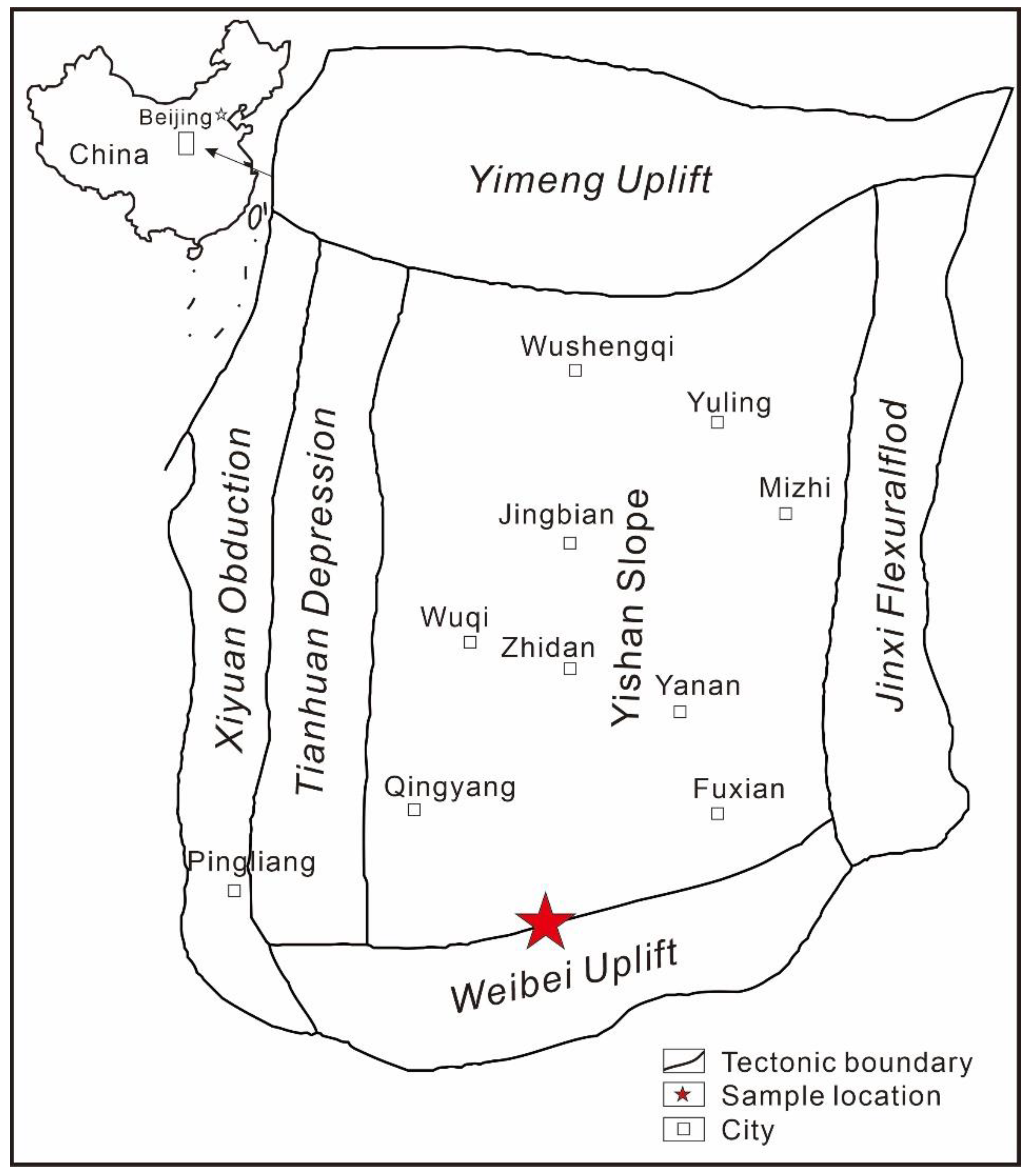
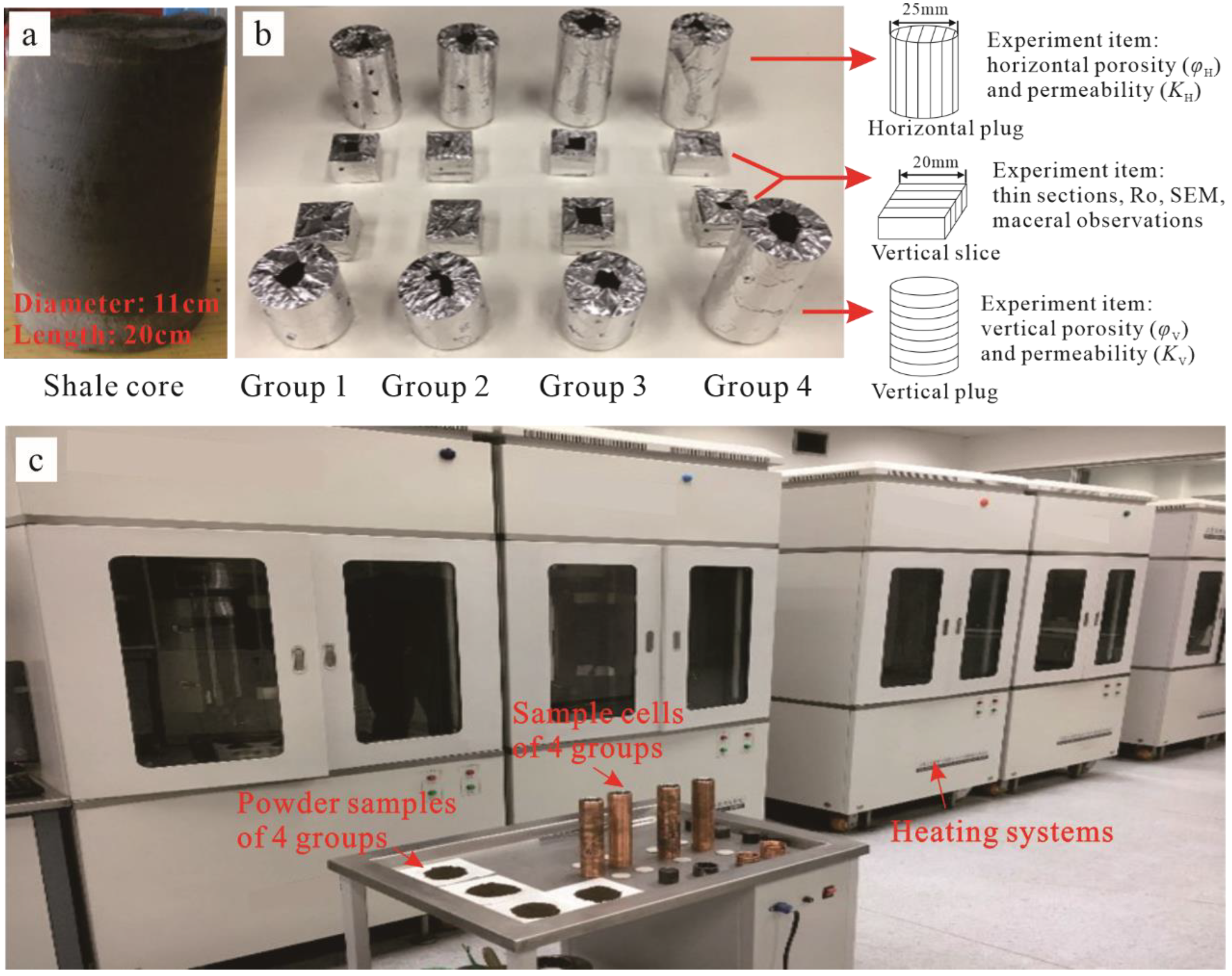
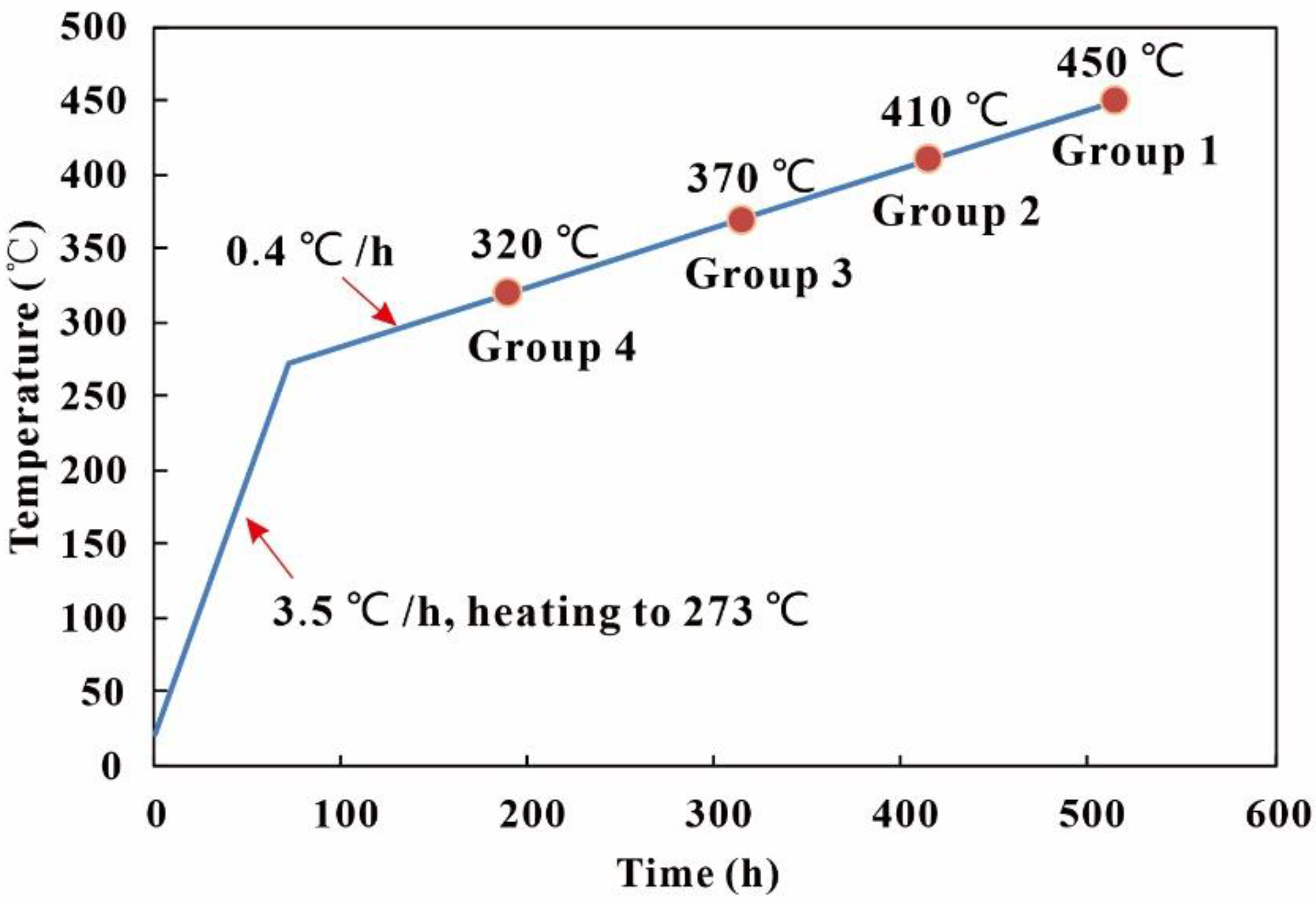
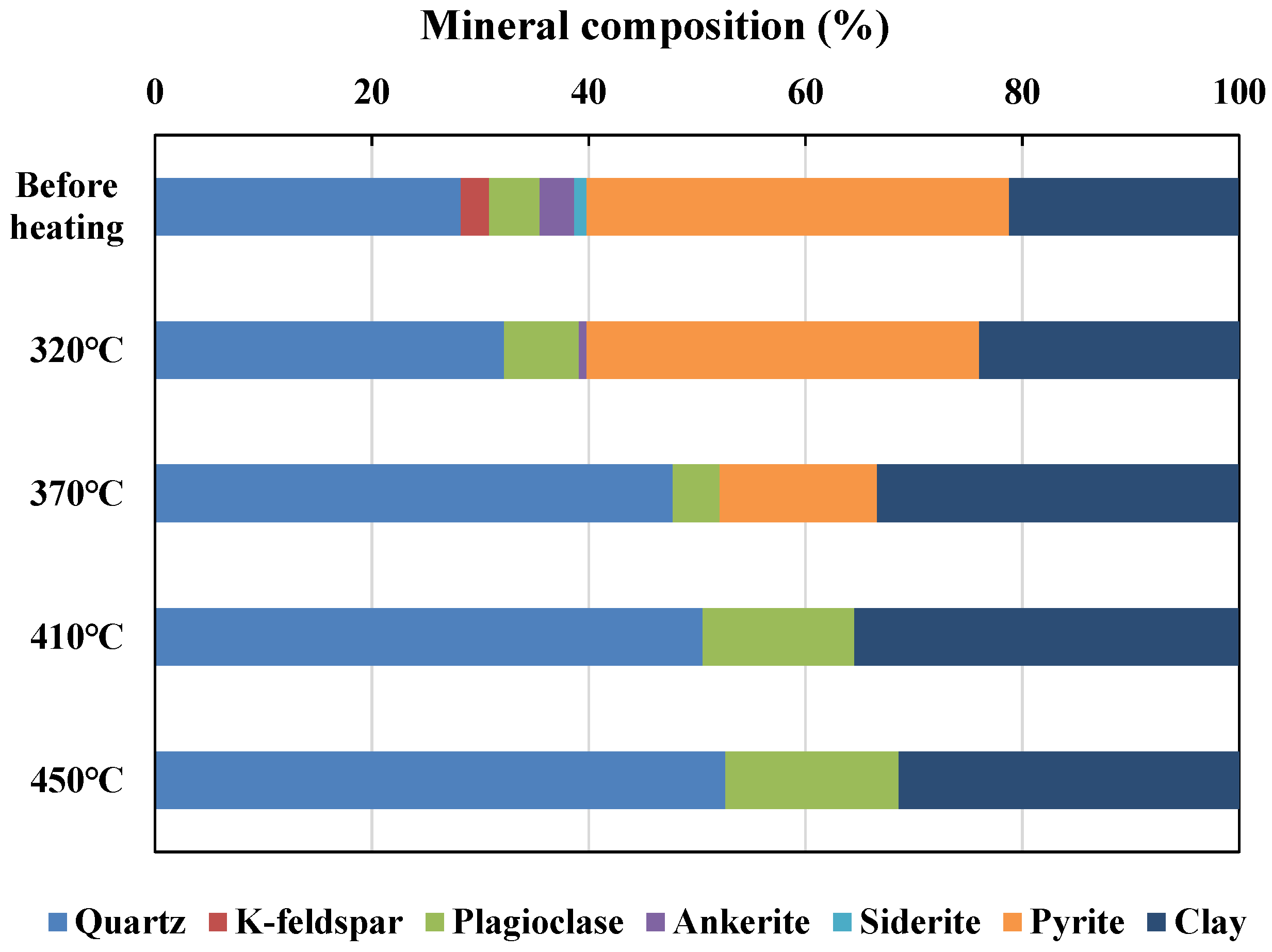


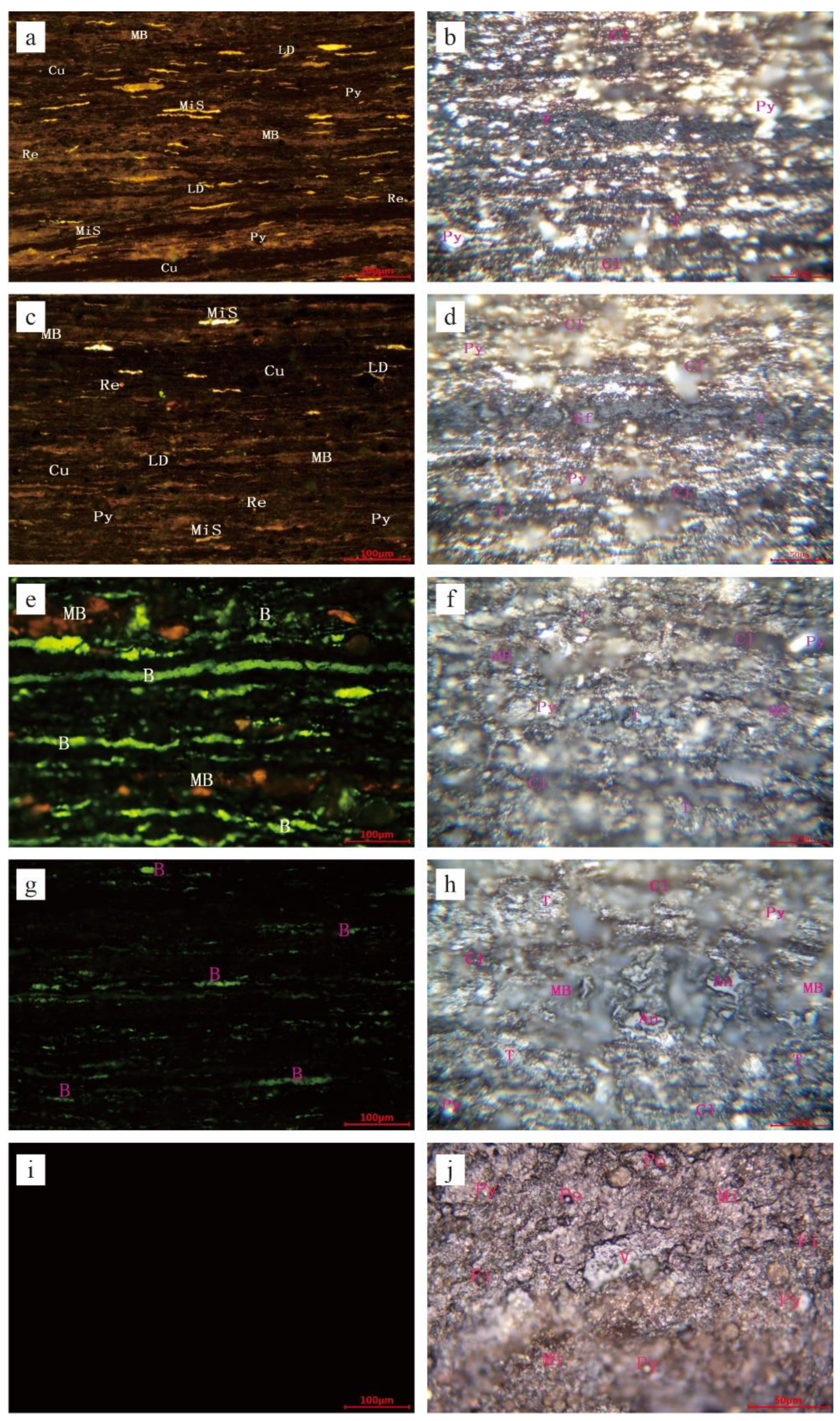


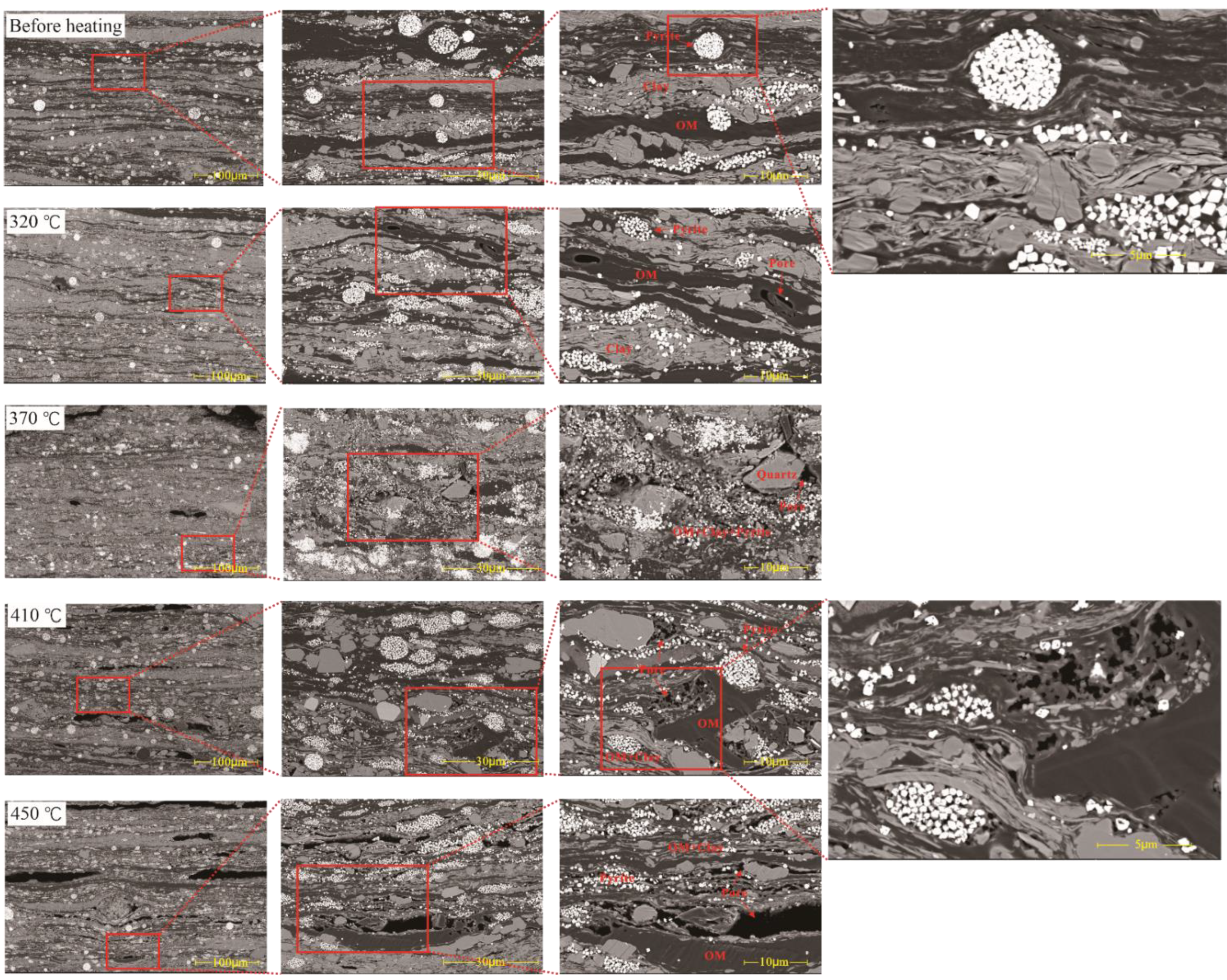
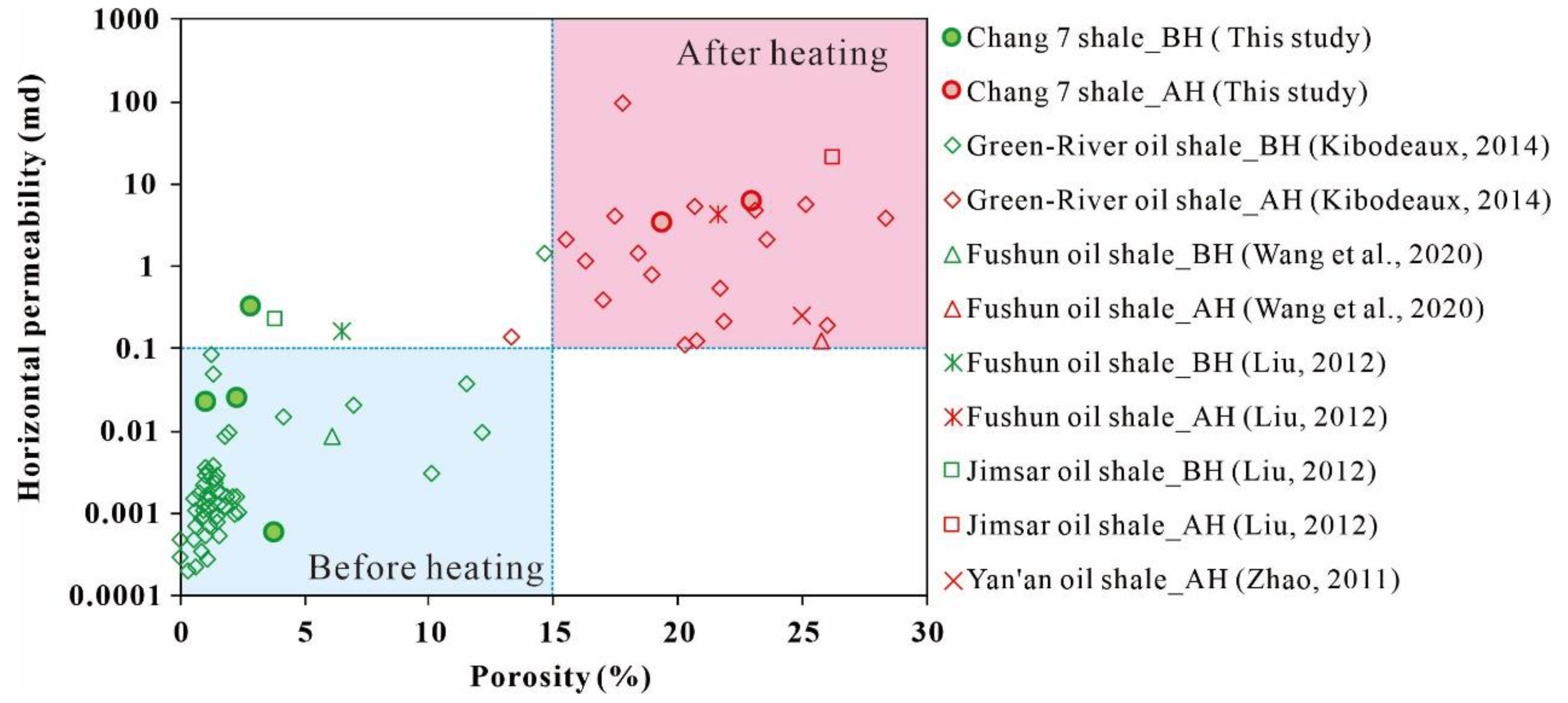
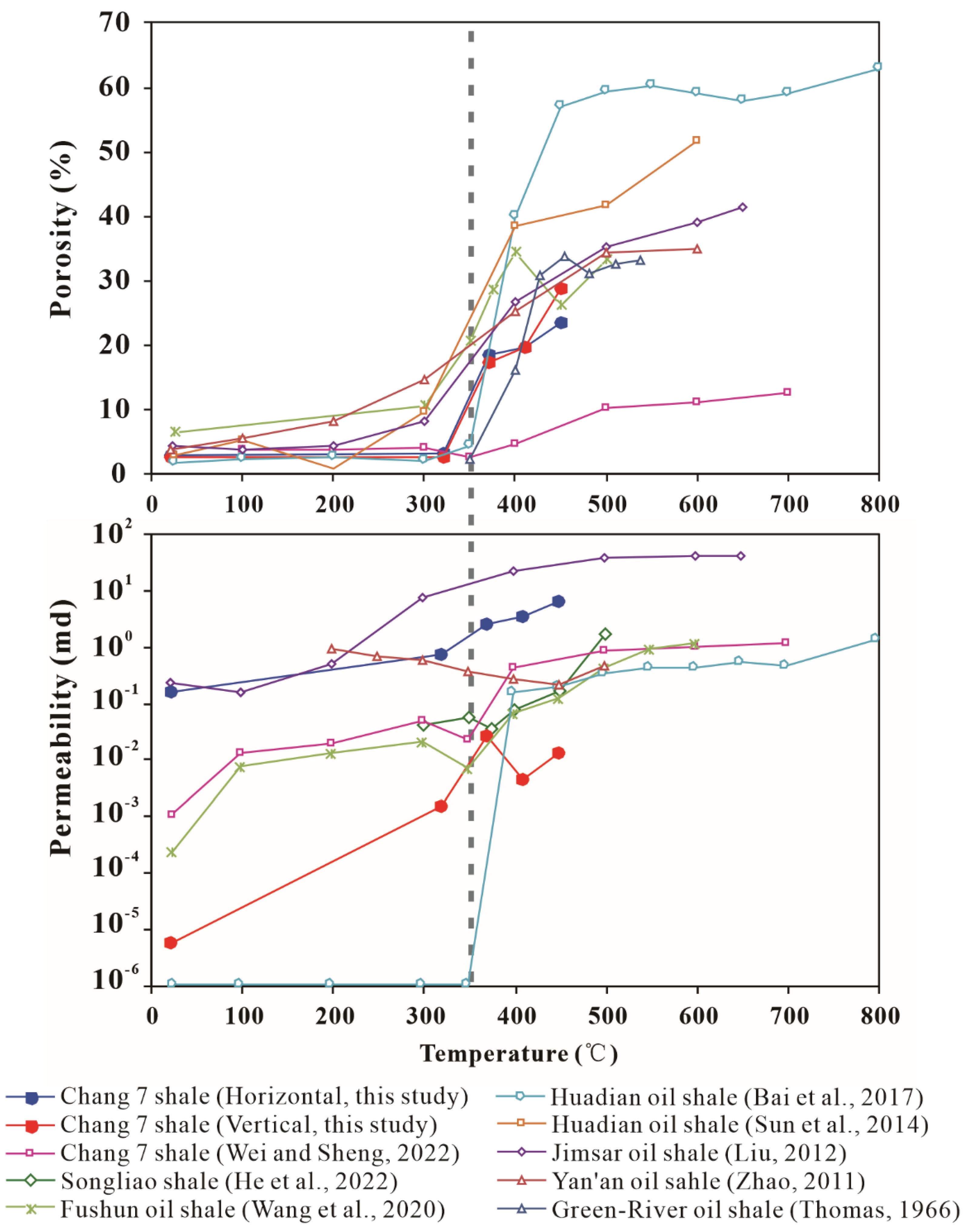
| Sample Number | Heating Temperature (°C) | Ro (%) | Effective Measuring Points | Standard Deviation (δn) | ||
|---|---|---|---|---|---|---|
| Min. | Max. | Ave. | ||||
| 0 | Before heating | 0.42 | 0.49 | 0.45 | 28 | 0.025 |
| 1 | 320 | 0.47 | 0.58 | 0.52 | 24 | 0.033 |
| 2 | 370 | 1.03 | 1.34 | 1.16 | 21 | 0.088 |
| 3 | 410 | 1.32 | 1.79 | 1.62 | 50 | 0.111 |
| 4 | 450 | 1.84 | 2.21 | 2.04 | 60 | 0.130 |
| Sample Direction | Sample Number | Length (mm) | Bulk Density (g/cm3) | Before Heating | After Heating | |||
|---|---|---|---|---|---|---|---|---|
| Porosity (%) | Permeability (md) | Temperature (°C) | Porosity * (%) | Permeability * (md) | ||||
| Horizontal | H1 | 51.41 | 2.20 | 2.84 | 0.4800 | 320 | 2.95 | 0.4412 |
| H2 | 52.01 | 2.11 | 3.83 | 0.0012 | 370 | 18.10 | 2.5441 | |
| H3 | 43.80 | 2.19 | 2.32 | 0.0588 | 410 | 19.42 | 3.3925 | |
| H4 | 43.60 | 2.17 | 1.07 | 0.0700 | 450 | 23.05 | 6.1944 | |
| Average | 2.51 | 0.1525 | - | 15.88 | 3.1431 | |||
| Vertical | V1 | 51.58 | 2.09 | 3.05 | 0.000005 | 320 | 2.33 | 0.0015 |
| V4 | 26.31 | 2.03 | 1.59 | 0.000004 | 370 | 16.81 | 0.0263 | |
| V3 | 25.04 | 2.17 | 1.85 | 0.000003 | 410 | 19.27 | 0.0043 | |
| V2 | 30.77 | 1.97 | 1.86 | 0.000009 | 450 | 28.39 | 0.0133 | |
| Average | 2.09 | 0.000005 | - | 16.70 | 0.0114 | |||
Disclaimer/Publisher’s Note: The statements, opinions and data contained in all publications are solely those of the individual author(s) and contributor(s) and not of MDPI and/or the editor(s). MDPI and/or the editor(s) disclaim responsibility for any injury to people or property resulting from any ideas, methods, instructions or products referred to in the content. |
© 2023 by the authors. Licensee MDPI, Basel, Switzerland. This article is an open access article distributed under the terms and conditions of the Creative Commons Attribution (CC BY) license (https://creativecommons.org/licenses/by/4.0/).
Share and Cite
Zhao, Z.; Hou, L.; Luo, X.; Chi, Y.; Pang, Z.; Lin, S.; Zhang, L.; Liu, B. Heat-Induced Pore Structure Evolution in the Triassic Chang 7 Shale, Ordos Basin, China: Experimental Simulation of In Situ Conversion Process. J. Mar. Sci. Eng. 2023, 11, 1363. https://doi.org/10.3390/jmse11071363
Zhao Z, Hou L, Luo X, Chi Y, Pang Z, Lin S, Zhang L, Liu B. Heat-Induced Pore Structure Evolution in the Triassic Chang 7 Shale, Ordos Basin, China: Experimental Simulation of In Situ Conversion Process. Journal of Marine Science and Engineering. 2023; 11(7):1363. https://doi.org/10.3390/jmse11071363
Chicago/Turabian StyleZhao, Zhongying, Lianhua Hou, Xia Luo, Yaao Chi, Zhenglian Pang, Senhu Lin, Lijun Zhang, and Bo Liu. 2023. "Heat-Induced Pore Structure Evolution in the Triassic Chang 7 Shale, Ordos Basin, China: Experimental Simulation of In Situ Conversion Process" Journal of Marine Science and Engineering 11, no. 7: 1363. https://doi.org/10.3390/jmse11071363






